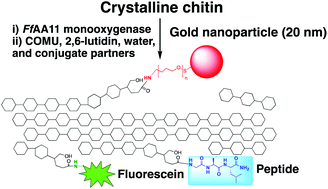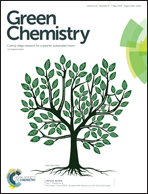Production of functionalised chitins assisted by fungal lytic polysaccharide monooxygenase†
Abstract
The gene CCT67099 from Fusarium fujikuroi was shown to encode a novel enzyme from the Lytic Polysaccharide Monooxygenase (LPMO) Family AA11. The gene was expressed and a truncated version of the enzyme, designated as FfAA11, was purified from the periplasmic space of Escherichia coli cells at high yield. FfAA11 exhibited oxidative activity against α- and β-chitins, as well as lobster shells. Under optimised conditions, FfAA11 introduced 35 nmol of carboxylate (COO−) moieties per milligram of α-chitin. These carboxylate groups were introduced onto the chitin surface under mild enzymatic oxidation conditions in an aqueous solution without changes to the crystallinity of the chitin fibres. FfAA11 was also combined with a simple and environmentally friendly chemical method that transforms recalcitrant chitins into desirable functionalised (nano)materials. The use of ethyl(hydroxyimino)cyanoacetate (Oxyma)-assisted click chemistry allowed the rapid modification of the surface of FfAA11-oxidized chitins, with a fluorescent probe, a peptide, and gold nanoparticles. The chemical steps performed, including the FfAA11 oxidase treatment and surface chemical modification, were achieved without the production of any toxic by-products or waste organic solvents. This approach represents a novel method for the greener production of chitin-based biomaterials.



 Please wait while we load your content...
Please wait while we load your content...